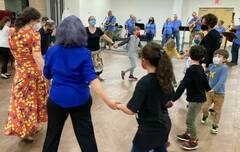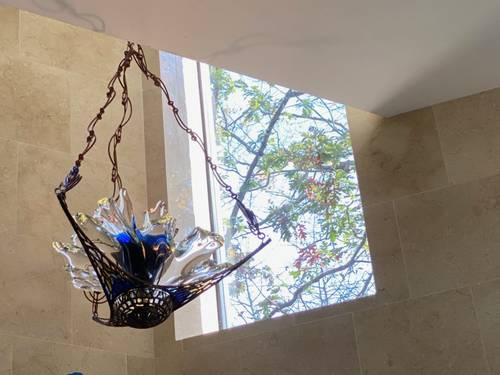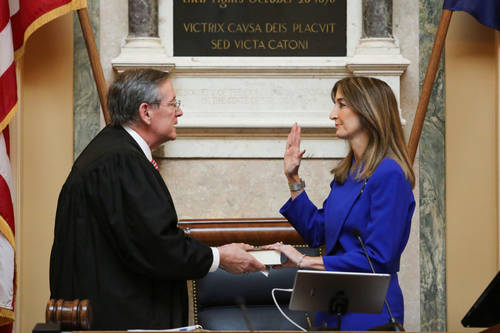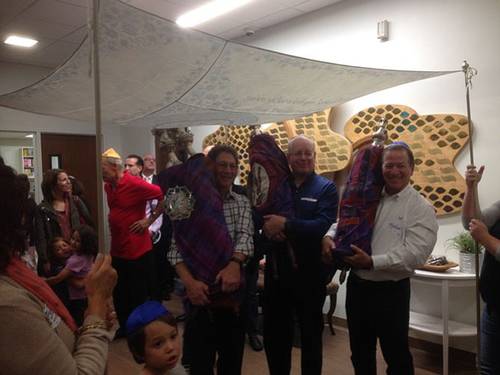In The News
Adat Reyim is actively involved in events and programs of interest to the Northern Virginia Jewish community. Occasionally we are recognized by local newspapers and television stations for our participation; sometimes we contribute to those sources ourselves. You can read about some of our activities below or by clicking the links posted.
Adat Reyim Diversifies its High Holiday Offerings - Washington Jewish Week
 By Jill Diamond
By Jill Diamond
There are themes that are common in high holiday services at most congregations — repentance, renewal and the start of a new year, for example. Some synagogues also choose a theme to teach about certain concepts or to focus on specific needs of their community.
The theme this year at Congregation Adat Reyim in Springfield is providing diverse opportunities for diverse families.
“What we want to do here is to give everyone an opportunity to have a meaningful holiday experience, and that means different things to different people,” said Interim Rabbi George D. Billinson. “All of our programs are family-friendly, but we wanted to provide opportunities, for example, for families with young children in addition to traditional services.”
Adat Reyim has always geared its services to a multi-generational membership, having also offered babysitting for those too young to attend services. But this year they are planning more events than in the past that are suitable for entire families. On Erev Rosh Hashanah — Sept. 15 — Billinson plans to host an interactive musical program for young children, followed by an outdoor service.
“One thing we learned from the COVID-19 pandemic is that people really enjoy outdoor services,” said Eileen Kugler, an Adat Reyim member and part of the synagogue’s communications team. “They are more inclusive, too, since there are still some people who are not comfortable attending indoor services.”
After the pandemic, Adat Reyim began to reevaluate how they hold high holiday services. As a result, the aim of their high holiday-related programming this year is to create opportunities for families that meet their varied needs and approaches to the holidays.
The synagogue will also offer two different types of high holiday services held consecutively: Traditional services, which feature a choir, and the Spirit of the High Holidays services, which feature communal singing with guitars and a more casual atmosphere. In the past, these two types of services ran at the same time, forcing people to choose. Now members can attend both.
“I think it comes down to the idea of finding what speaks to people, how they connect with their God spiritually, and everyone is a little different,” Billinson said. “Instead of trying to fit everyone into one particular format of a service, we spend a lot of time talking to people and finding out what is meaningful to them. And we offer different things so people can try events and formats they’ve never tried before.”
Billinson added that while Adat Reyim is a relatively small congregation, they have a diverse member base that they want to accommodate.
“We have members from a wide variety of backgrounds and experiences and paths to spirituality. And we use that as a strength,” Kugler said. “We all learn from each other.
”The congregation also has a focus on music, including the sound of the shofar. They will be sounding the shofar at their ShabaBBQ on Aug. 25, and while they will not be sounding it during Shabbat, they invite anyone who can blow a shofar to join them at Tashlich at Lake Accotink to mark the end of Rosh Hashanah.
On the eve of Yom Kippur — Sept. 24 — Adat Reyim will incorporate a string quartet into the first recitation of Kol Nidre, with the choir performing the second and third recitations. Kugler noted that diverse music is a common part of the congregation’s services.
The core of their high holiday observance is the fact that not every family or individual celebrates the same way. The synagogue wants to provide ways for everyone to worship comfortably in the company of their community.
“One thing that attracted me to Adat Reyim and got me to familiarize myself with them was their willingness to think outside the box and innovate,” Billinson said. “It is very easy for a congregation to become complacent, and that is the worst thing that can happen. We want to constantly think about how we can do things better, and make services more meaningful for our members.”
https://www.washingtonjewishweek.com/adat-reyim-diversifies-its-high-holiday-offerings/
You should Know - Stephanie Kruskol -Washington Jewish Week
 BY Orrin Konheim
BY Orrin Konheim
Stephanie Kruskol, 36, is a classically trained vocal musician who works as a solo performer, voice teacher and piano teacher. She is a member of Adat Reyim in Springfield where she is active in the choir. As the congregation does not have a permanent cantor, she has often had a leading role in services.
Raised in New Hampshire by a Puerto Rican mother and a Jewish father, she converted to Judaism 15 years ago.
How does Adat Reyim fit in with what you prefer musically?
One of the things that drew me to Adat Reyim was seeing that they had two separate musical ensembles. A lot of congregations either only have a folk group or they combine both folk and traditional into one group. I love and enjoy folk music and have participated in some of the folk-based services here, but my comfort zone is in the choral tradition and it’s what makes me feel more spiritually connected.
As a conservatory-trained musician, do you have any insight on the fact that a lot of classical music is inherently Christian? Does Judaism have much of a stamp on the classical world at all?
about. A lot of the work that I get is singing Christian music, including secular environments, like singing a lot of Bach. Most of Bach’s music is sacred even if it’s performed at a concert hall. I was part of a concert in Baltimore where we performed the work of Salomone Rossi. He was an Italian composer from the Renaissance and he was Jewish.aissance Christian music, you might not know what language it‘s in, but if you listen carefully, it’s in Hebrew.
The problem is, because of systemic oppression, a lot of it got lost. And also the difference in traditions: The Christians started writing music down more commonly and earlier than Jewish musicians. But there’s an incredible wealth of choral Jewish traditions that I really love doing and I’d love to get more involved in.
I’ve always assumed that Judaism was challenged by the fact that a lot of worship has less emphasis on reading sheet music or learning music.
There’s a lot of disagreement about what should be in the context of worship, because there’s a wealth of fully notated, really grand-sounding choral music in the Jewish liturgy, and a lot of it was by 19th century composers who would take an oral melody and write it down and set harmonies.
So the stuff exists. But there’s some resistance, that I can empathize with, that people don’t want to listen to a concert when they’re at a service worshipping. But there are some people who feel very transported and that’s what wakes them up.
What was your conversion process like?
I grew up in an interfaith home — my father’s side of the family is Jewish — and although I was raised in another faith, my Jewish heritage was always celebrated. It wasn’t just a footnote about distant ancestry, it was something that was still part of my upbringing culturally, and we celebrated Jewish holidays as a family.
So when I finally took classes in order to convert and affirm that pride in my heritage, I was already familiar with a lot of what we were required to know. It just confirmed what I knew was true for a very long time.
You recently introduced a Puerto Rican cooking workshop at Adat Reyim. Why cooking?
A lot of the cuisine is Passover friendly. The stuff that doesn’t have pork. There are so many vegetables that are Passover-friendly starches. After a while, I had an idea about introducing people to Puerto Rican cuisine. ■
https://www.washingtonjewishweek.com/you-should-know-stephanie-kruskol/
New Energy - New Light - New Inspiration!

Eternal Light Watches Over Adat Reyim
By Eric Schucht
Congregation Adat Reyim in Springfield began renovating its sanctuary and lobby about six years ago. So far, they’ve worked on the floors, ceilings, lighting and walls.
But the “pièce de résistance,” as congregant Andrea Cate describes it, is the new ner tamid, or eternal light, that hangs above the ark.
The eternal light was created by Minneapolis glass artist Claude Riedel. Cate said Riedel makes them in memory of his grandfather, who was imprisoned at Buchenwald concentration camp in Germany following Kristallnacht.
“The fact that Claude is now using his talents and his creativity to take broken glass and make it whole in his glass work is very meaningful,” Cate said.
Link to the full article in Washington Jewish Week - February 10, 2021
VA Speaker of the House, Eileen Filler-Corn, Adat Reyim member, maintains strong ties to our congregation

Repairing the World from the Virginia Statehouse
by Gabby Deutch
In Washington, D.C., the synagogues of choice for prominent politicians, pundits and the literary set are seen as spiritual status symbols. Indeed, certain ambitious political types have been known to choose a popular congregation because of its prestigious membership roster.
Supreme Court Justices Elena Kagan and Ruth Bader Ginsburg attended High Holiday services at Adas Israel Congregation in Cleveland Park. Former Treasury Secretary Jack Lew famously did not work on Shabbat, which he often observed at Georgetown’s Kesher Israel, where Joe Lieberman was also a member when he served in the U.S. Senate. During the Trump administration, Jared Kushner and Ivanka Trump attended services at the D.C. Chabad in Kalorama.
Half an hour from downtown D.C., in Springfield, Va., Congregation Adat Reyim does not have the name recognition or the cachet of the Beltway’s most esteemed congregations. But the synagogue has long counted Eileen Filler-Corn as a member. Elected to Virginia’s House of Delegates in 2010 by a margin of just 37 votes, Filler-Corn, a Democrat, is now entering her second year as Virginia’s speaker of the House — the first Jewish person and first woman to hold the position. A year ago, just before she struck the gavel for the first time, she attended a celebratory Havdalah send-off at Adat Reyim. The music of choice? Filler-Corn’s favorite: Debbie Friedman, the late Jewish folk musician whose music is a mainstay at Reform congregations and summer camps.
Link to the full article in Jewish Insider - February 3, 2021
Congregation supports member Lt. Col Vindman
Community Embraces Vindman Family by Susan Laume
Vindman family’s small congregation, of about 250 members and families, overwhelmed by hundreds of letters in support of the Vindmans.
On Friday, Feb. 7, Lt Col Alexander Vindman was removed from his job on the National Security Council and escorted from the White House.
In a statement, his counsel, Ambassador David Pressman, said “There is no question in the mind of any American why this man’s job is over, why this country now has one less soldier serving it at the White House. …During his decades of service to this country, LTC Alexander Vindman has served quietly but dutifully, and he has served with honor.
Link to the full article in the Connection Newspaper - February 15, 2020
Honored Member
Virginia's first female, first Jewish Speaker: Eileen Filler-Corn by Lisa Richmon
Diversity across the Commonwealth. Diversity in the House.
Eileen Filler-Corn’s historical new role as the Commonwealth of Virginia’s first woman and first Jewish Speaker of the House of Delegates is big news, locally, nationally, and even in Israel. Since November, Filler-Corn has been on the cover of Hadassah Magazine, Virginia Business, featured on NPR, in the Times of Israel, and in many other Virginia publications, including on the front page of the Virginian-Pilot.
Link to the full article in the JewishVA.org - January 16, 2020
Synagogue Redesign Looks Toward Inclusiveness

Springfield — As the Congregation Adat Reyim in Springfield danced and sang to “Tsena Tsena,” the togetherness and friendship of a religious community was perfectly clear. Although they were celebrating the new sanctuary of the congregation, they already had the togetherness they sought, and were creating a new sanctuary as a look in the future of inclusiveness.
It all started with the need for a wheelchair ramp, and ended in something so much more.
“We started dreaming,” said Andrea Cate, the chairperson of the rejuvenation committee. “Like our parents did for us, we do for our children,” Cate said.
Photo by Mike Salmon
Andrea Cate hangs two new mezuzah’s on the synagogue door. One was lower for the children or wheelchair access, keeping in theme with the inclusiveness.
Rabbi Bruce Aft reiterated that feeling, as he said a few words before the ribbon was cut and the doors to the newly refurbished space opened. “This is what it’s all about,” he said as he called the children up front to hang a new “mezuzah,” which is an object in the Jewish faith hung by doors to bless the home.
The band played on as everyone danced.
The evening started out with a barbecue out front and then the clapping and dance began, as the “chuppah,” a Jewish canopy, was erected and scrolls of the Torah beneath the chuppah were brought into the new space, which featured a new wheelchair ramp to make the altar accessible to all. “This keeps with our theme of being inclusive,” said David Berkowitz, a member of the congregation.
Rabbi Aft said the torah, which is an altar, is a tree of life. “It will make it more inclusive, building on what was here,” he said. “Create energy and still attract younger folks,” he said.
The building committee came up with three factors that the congregates want for a new worship space to:
- be inclusive and welcoming
- foster connections among family and community
- connect the congregation to nature
The nearly $800,000 project included a relocated wall, new furniture, flooring and a window to the exterior. Although the ribbon was cut and the festivities ensued, the project is only 85 percent complete. The project will be completely finished by Rosh Hashanah, which is Sept. 20.
When there was a break in the music and dancing, there was a reading that stated: “May each of us be inspired to create a community of friends.”
Adat Reyim to Launch Parent Education Program on Cultivating Compassion
by Oren Litwin (APR 26, 2018)
This fall, Congregation Adat Reyim of Springfield, Virginia, will launch a new parent education program, “Cultivating Compassion in Our Kids and Ourselves.” Funded by a $50,000 grant from the Greater Good Science Center of UC Berkeley (part of a larger grant made to the Center by the John Templeton Foundation), the program aims to introduce parents to a uniquely Jewish perspective on raising compassionate children, and to explore how it closely parallels the newest research in neuroscience about the foundations of ethical behavior.
The program development team includes Rabbi Bruce Aft of Adat Reyim, several parent facilitators, and Rabbi Dr. Marc Gopin, director of George Mason University’s Center for World Religions. Ordained at Yeshiva University, where he was a student of Rabbi Joseph Soloveitchik, Rabbi Gopin has most recently published “Compassionate Judaism: The Life and Thought of Samuel David Luzzatto.” “Science and Judaism have been running on parallel tracks for 200 years and have arrived at the same conclusion: Compassion is the cornerstone of ethical behavior,” he said.
Held over two years, the program will consist of 10 sessions made up of modules built around different parenting topics. Each module will feature one expert-led “Compassion Workshop” and one parent-led “Compassion Dialogue.” Parents can attend any of the sessions they like, and those who attend six or more sessions will receive a cash award and be recognized as a Parent Leader at Adat Reyim.
The program is meant to be accessible for parents who are new to studying the Jewish tradition, but at the same time deep enough to engage those with a more extensive background.
“We’re creating relevant and authentic points of entry into Jewish learning and community life,” said Adat Reyim executive vice president Dr. Shira Solomon, who recently participated in the Partnerships for Advancing Character Program Education, also funded by the John Templeton Foundation. “We’ll tap traditional texts and rituals as well as contemporary sources and practices.” But sessions won’t be mere lectures; the goal is not just to receive knowledge from experts, but to collect and create knowledge among peers. “I wrote the program I would want to participate in,” Solomon said, “and I do want to participate in it.”
Solomon, who has an extensive background in educational research and program evaluation, noted that many school-based and informal educational programs claim to be teaching their students character — but often don’t have a clear idea of the character outcomes they are trying to teach. There are many models of character, and a character-based educational program needs to define the concept so that it can resonate in the larger community’s schools, synagogues, and homes.
This is where the Jewish tradition can make a key contribution. “Parents are the frontline moderators of an overwhelming world,” said Rabbi Aft. “Judaism has so much to offer people as they raise their families. We need to spark dialogue, within families and in our community, about what it means to practice compassion towards oneself and others.”
By Oren Litwin
Interfaith Thanksgiving Service
Burke — Co-pastors at Burke Presbyterian Church Rev. Meg Peery McLaughlin and her husband Rev. Jarrett insist the interfaith Thanksgiving service held in their worship hall on Nov. 22 was not in response to any perceived disunity in the country following the Presidential election.
#In fact, this was the 33rd annual service participated in jointly by Burke Presbyterian, the Congregation Adat Reyim in Springfield and Saint Mary of Sorrows Catholic Church in Fairfax.
#Ezher Bloom Mosque of Fairfax joined a number of years ago, Jarrett said, and in 2013 members of St. Andrew’s Episcopal Church of Burke and the Durga Temple of Fairfax Station also became involved.
#“We feel fortunate to lean on the good interfaith work of generations before us and that this kind of work is Burke Presbyterian’s DNA,” said Jarrett.
#Jarrett’s wife Meg admitted, however, “We really needed it this year. Post-election, there’s a lot of anxiety about the country.”
#The huge turnout from multiple faith communities Tuesday night, Meg called “a huge sign of hope.”
#“You can lament about the hate in the country right now,” she said, “but there’s a great sense of readiness to act in a different way, that we’re capable of being different and being together.”
#The service featured traditions of prayer and musical performance from Christianity, Islam, Hinduism and Judaism, including individual groups from the participating faith communities and a combined choir.
#Jarrett delivered the thanksgiving message, or sermon. In it, he meditated on Psalm 46 from the Bible, including the line “God is in the midst of the city; it shall not be moved; God will help it when the morning dawns.”
#He referenced Spanish-speaking illegal immigrants being confronted at a worship service with a banner spray-painted telling them it was for “whites only,” a man wearing a “Make America Great Again” hat being assaulted while riding the subway and a Muslim girl being called a terrorist for wearing a hijab to school.
#“I refuse to believe that God is unmoved by this or anything else that undermines any one of God’s creations,” Jarrett said. “And so I don’t want to be unmoved either.
#“When we are moved in our hearts – when we allow the pain of our neighbors, especially those who are different from us, to move us in here,” Jarrett began to conclude, “when we are honest about what troubles us and when we listen to one another’s stories and when we hold those secret hurts together, I believe that is when our unity becomes stronger, when we dig in even deeper until we cannot, in fact, get tossed around by the raging of the nations.”
#In an interview, Meg reiterated that the hard work of being united is not about “polishing off our differences,” but rather celebrating them.
#“It’s OK to not be the same. We don’t dilute our faith. But how can we be different, distinct, and still be friends?” she asked. “We need to understand our differences. Sameness, we’ve had enough of that.”
Lay-led music has congregation following beat of its own folk group, choir
As Congregation Adat Reyim choir member Frannie Nadel looked out at the audience bopping their heads and clapping along to the music on Saturday night in Springfield for the synagogue’s “Praise and Inspiration!” concert, she knew that the year-and-a-half of planning and practice had paid off.
clapping along to the music on Saturday night in Springfield for the synagogue’s “Praise and Inspiration!” concert, she knew that the year-and-a-half of planning and practice had paid off.
That hard work culminated in the concert that, for the first time, combined the choir, under the direction of Mitch Bassman, with the Shir Reyim folk group, under the direction of Larry Kugler and Russell Nadel, brother of Frannie.
Frannie Nadel is testament to the drawing power of the thriving lay-led music scene at Adat Reyim. She became a member when her brother and sister-in-law were looking to affiliate with a synagogue.
“They found this place, and they said, ‘You’ve got to come along. They’ve got a chorus. They’ve got a folk group. I think you’re really going to like it.’ So I was like, ‘Sure, why not,’” explains Nadel. “So I went along and I happened to be there for the High Holidays where the choir leads services. And the music was amazing. It was a four-part choral harmony to a lot of the melodies that I had grown up with and I just sat there going, ‘I want to do this. I want to be part of this chorus.’ And so I joined.”
Some might view the lack of a cantor as a minus musically for the congregation, according to Adat Reyim President Andrea Cate.
“We have freedom at Congregation Adat Reyim musically. We don’t have a cantor, which many of us wish we did. But we don’t. And so this allows us the freedom to create our own music,” Cate says.
Bassman founded the choir in 1983 with nine members. There are now 16 members who perform at two Shabbat evening services each month. Kugler founded the folk group in 1998 with six members. Today it has 12 members, including four or five musicians depending on the piece they are performing. The folk group performs monthly in the sanctuary.
The program included joint musical selections that required choir members and folk members to get out of their comfort zone. Some of the folk members who were used to more improvisation had to learn to read off the page while some choir members used to sheet music had to learn to “loosen up,” as Bassman describes.
Guest performers included students from the Adat Reyim Religious School and tenor soloist Alexander Kugler, son of Larry Kugler and his wife Eileen, who returned from San Francisco to his hometown synagogue to sing on Yah Ribon Alam. The wide-ranging musical selections included big choral pieces like Hal’lyua to the Ladino song Los Bilbilicos to the Klezmer medley Stompin’ at the Synagogue and even a rendition of Take Me Out to the Ballgame.
An unaffiliated congregation, Adat Reyim was founded in 1981 by three Northern Virginia families and has grown to nearly 300 families under the leadership of Rabbi Bruce Aft, the congregation’s spiritual leader since 1991.
Aft says the music is a “gateway to spirituality” for the folk and choir members.
“We’ve always been real supportive. And it’s just so nice to feel their energy and that’s something that’s really special.”
jmarks@midatlanticmedia.com
@JoshMarks78
A Small Congregation Paves Their Jewish Legacy
We wo uld like to introduce you to Elizabeth Bayer (Executive Director) and Steve Schwartz (CJL Volunteer) of Congregation Adat Reyim in Northern Virginia. Despite its relatively small size, Adat Reyim has secured the most letters of intent of all participating Create a Jewish Legacy (CJL) teams in the region. We visited Adat Reyim to find the secret to their success.
uld like to introduce you to Elizabeth Bayer (Executive Director) and Steve Schwartz (CJL Volunteer) of Congregation Adat Reyim in Northern Virginia. Despite its relatively small size, Adat Reyim has secured the most letters of intent of all participating Create a Jewish Legacy (CJL) teams in the region. We visited Adat Reyim to find the secret to their success.
Steve responds to our inquiry somewhat puzzled. He relays that he simply doesn’t understand why anyone would not establish a legacy to support an organization that they care about. He remarked thaton hearing about the CJL program, “I thought, this is the first time we’re going to ask someone to give money without writing a check. Surely, folks would just jump on it.” He has personally solicited 50% of the 270 families who make up the Adat Reyim community.
Many people respond to Steve’s approach by suggesting that they are leaving everything to their children. Again, Steve in his jovial but incisive way responds by asking his prospects: “How much will aninheritance of $95,000 instead of $100,000 truly affect your children? Yet, how much of an impact would the $5,000 per child have on the small and caring Congregation?”
Within minutes, it is quite obvious that the essence of Adat Reyim’s success lies in Steve, himself. Elizabeth notes that: “Steve is the mensch of our congregation. He is the support of theoffice, he is the Mr. Fix-It, he is the Friday night baby walker, and he is the closest thing to a grandfather for most people.” It is clear that Steve’s personal relationship and commitment to the Adat Reyim community has resulted in a range of CJL conversations.
Steve’s love for Adat Reyim started simply after his wife “dragged” him to Adat Reyim in the 80’s, when it became time for their son to prepare for his Bar-Mitzvah. He attended a few events, a board meeting, and was then asked to become president. Steve remarks of Adat Reyim, “This is Cheers to me. This is a place where everybody knows my name.”
But how did Steve’s legacy asks get started? Steve shifts from his light-hearted predisposition, tears well in his eyes and he relays the story of how the first legacy conversation he had was with his own children, when he contacted them to let them know he intended to leave 10% of his estate to the Congregation. Their support proved to be the biggest validation of Steve’s love for his community and it set him on the path to rallying others to remember Adat Reyim in their final estate plans.
We take this opportunity to applaud Steve and thank him for his tremendous efforts. We also derive important lessons about CJL from Adat Reyim’s example.
******
More on the Legacy program:
To Build an Endowment, You First Have to Ask by David Holzel, November 2013. This article contains quoted statements from Elizabeth Bayer, member and Executive Director and Steve Schwartz, member regarding the Create A Jewish Legacy Program.



